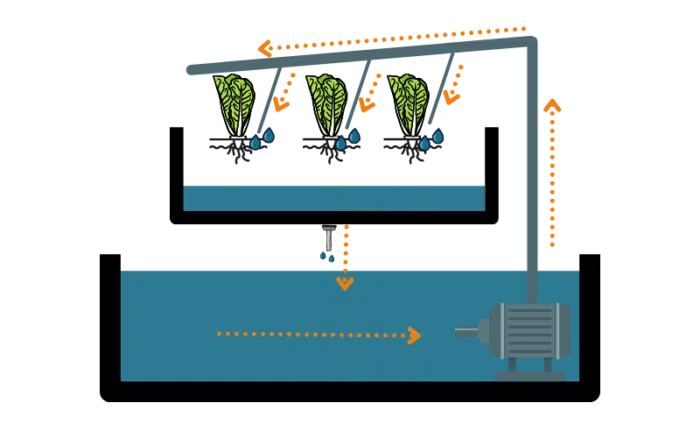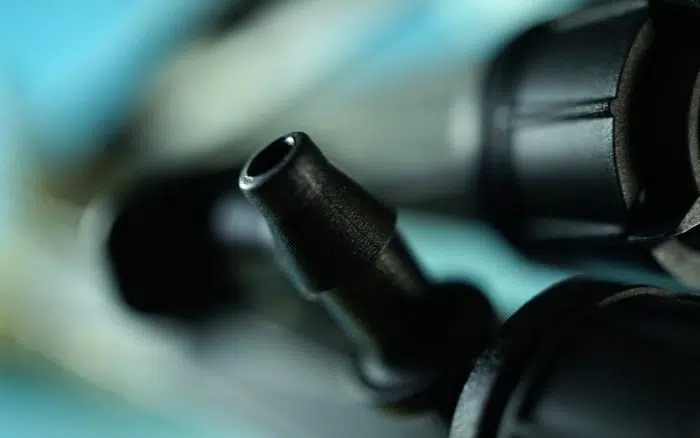When it comes to hydroponics, there are 7 different hydroponic systems you can follow to grow your plants.
The Drip System is one of the simpler methods for hydroponics, but is very effective and often used by commercial growers. Let’s walk through a drip system and see how it works.
What is a Hydroponic Drip System?
A drip system is a type of active hydroponic system and a slow watering system that essentially does as its name suggests: it drips a water and nutrient mixture onto the plants roots, and the excess is cycled back up to the top with a pump.
Because the water and nutrients are used over and over again, this is considered a closed system.

Similar to drip irrigation in a typical garden, by slowly incorporating water for the roots to drink, you’re only giving the plant exactly what it needs, versus just dumping water into a pot of soil and watching the excess drain out.
Who Uses Drip Hydroponics?
This type of system is often used in commercial settings, such as greenhouses or large-scale farming operations. But home growers often set something similar up to grow their own food.
What Do You Need for a Drip Hydroponic System?
The hydroponic drip system does well in a variety of environments and thus, is flexible in terms of what you’ll need to create it. Here are some of the common items you’ll need to create a drip system:
- Drip emitters: these are going to drip the water and nutrient solution onto the plants roots. You’ll need one for each plant you are going to be growing.
- Nutrient solution reservoir bucket: this is where the water will begin and end.
- Water pump: a submersible water pump the water back to the start of the lines
- Thin tubing: connects the drip emitter to the water source
- PVC tubes or a grow tray: this is where water will drip down and where your plant pots will sit
- Air stone: Air stones help deliver bubbles of air to the water. This not only helps with water movement and reducing stagnation, but it increases the oxygen levels in the water which help the plants stay healthy.
- Air pump: to deliver air to the air stone and keep oxygen levels up
- Net pots: Net pots will hold the plant and its root system in place.
- Timer: the timer will automatically turn on and off the system as you set it
- pH Monitor: plants need a specific amount of pH to grow effectively. This is usually around 6.0-7.5, but the growing process can raise and lower pH, so you’ll need to keep an eye on this.
- Hydroponic Growing Medium: You’ll need something to grow your plants in, as just placing them in net pots isn’t going to work well. This can be something like rockwool or coconut coir blocks.
How Much Does a Hydroponic Drip System Cost?
The cost of a hydroponic drip system can vary wildly. If you’re looking to create a large scale commercial system, this could be tens of thousands of dollars. But if you’re looking for a simple at home setup, you can probably build something yourself for around $250-$500.
How Do Hydroponic Drip Systems Work?
A hydroponic drip system works by continuously delivering water and nutrients to plants roots. Using an air pump, the water is pumped to the top of the system, where it then flows through drip emitters down the drip lines where the nutrient solution directly reaches the plants roots.
Any excess is delivered back to the nutrient solution reservoir, where it gets cycled through the system over and over again.
If you’ve every seen a drip irrigation system in a garden, the concept is very similar, except in this method, we are pumping any excess solution back into the reservoir where it gets cycled through again.
This makes drip system hydroponics much more efficient than typical drip systems, and you’re conserving a ton of water because the plants are only taking in exactly what they need at the time.
Advantages of Drip System Hydroponics
Hydroponics and the drip system specifically have quite a few advantages over other growing methods.
Mostly Easy to Maintain
While there are some cleaning and pH monitoring you’ll have to do, for the most part the system runs itself.
Using a timer and gravity for draining the water back into the reservoir, most of the work is done for you.
Great Plant Growth
Plants grow faster in many hydroponic systems, and the drip system is no different. It’s said that you usually get around 30-40% faster growth than growing in soil.
This usually makes some of the disadvantages not really an issue for most people.
Uses Significantly Less Water
A hydroponic drip system uses a lot less water than growing in soil. Hydroponics is said to be one of the most sustainable methods for growing plants out there.
Disadvantages of Drip System Hydroponics
There are a few downsides to drip system hydroponics as compared to other hydroponics methods, and even growing in soil.

Clogged Drip Emitters
Drip emitters have very small holes through which they deliver the nutrient solution to the plants. If any of these were to get clogged, it could be disastrous for your plants as they wouldn’t be getting enough water.
You can reduce the probably of this happening by:
- Only using liquid nutrients to make sure everything is fully dissolved
- Cleaning the system regularly between every grow cycle to keep algae, bacteria, and old roots from clogging these lines.
pH & Nutrient Level Monitoring
Most crops have a variant in terms of how much pH they need to grow. Because of this, you’ll need to watch pH and nutrient levels to make sure your plants are getting the right nutrients.
You’ll need to monitor this daily to ensure you don’t have a total crop failure. Once you get the hang of this, it’s not much work. However, if you’ve never worked with hydroponic nutrients, this could be a little challenging up front.
Make sure to check your nutrient solution regularly!
Dependence on Electricity
If the electricity goes out even for just a few hours, you could lose your entire crop. Because this is an active system, meaning everything keeps flowing, if there is no power to move the water around, your plants could dry up and die, especially if you’re not home to remedy the situation.
Drip System Hydroponics: The Perfect System?
Whether you’re building a simple hydroponic drip system or a more complex one with automated pH monitoring and multiple reservoirs, growing plants this way is so effective. Not only for plant growth, but also for conserving water and getting higher yields from each crop.


